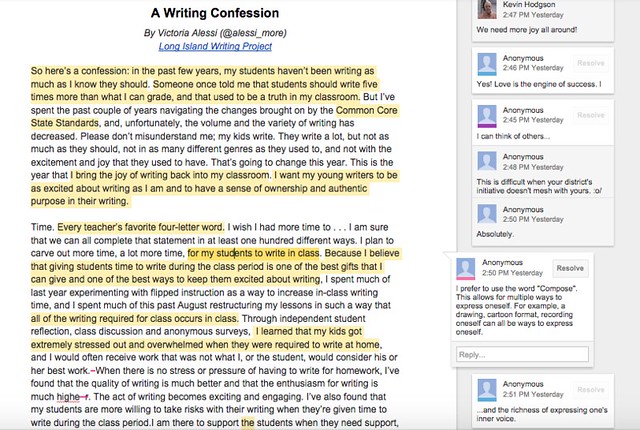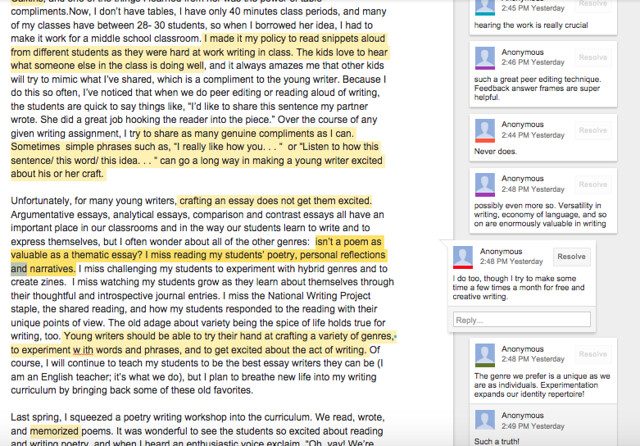In a recent discussion before the launch of Digital Writing Month, the idea of writing comments in the margins of collaborative documents as an act of shared composition became a topic of conversation for an edition of HybridPod. We were talking Google Docs, in particular, and it occurred to us (Chris Friend, Maha Bali, Sarah Honeychurch and me) that students probably need some explicit teaching of how to write in the margins of documents, particularly shared writing pieces.
This is fairly new to the teaching of writing, right? How many of us design a lesson around writing in the margins of books or stories and what that means to write? Mostly, this is because we traditionally all had only one story or one book or one text, and it was ours to write upon, highlight in pretty colors, mark up with Sharpies or crayons or whatever. It’s readability was only dependent on whether the writer could read it and make sense of it.
One text. One writer. One reader.
Collaborative writing in a digital space turns that on its head a bit. Now, it might be one text, but it might be multiple writers crowding into the margins, and it might be multiple layers of readers — the ones doing the writing, together, and maybe even an outside audience of readers.
One text. Many writers. Multiple readers.
Interestingly, I noticed this idea of “conversations about the writing” unfolding in my own classroom after a lesson on using Google Docs for peer review for short stories. My lesson had each student connecting digitally with another student, but once they knew how to share and get comments, they were sharing and asking for feedback from all sorts of friends … even students who were in our school district but not in our school.
I had to quickly give an impromptu lesson about the role of commenting, and the word “resolve” in Google Docs. Actually, that word become an anchor point in the discussion that Chris, Sarah, Maha and I had: what does it mean to “resolve” a comment? And who makes that decision? How do we un-resolve a comment? Does “resolve” mean I agree with you or does it mean I don’t want to see your comment anymore?
In a recent professional development workshop with the Western Massachusetts Writing Project, I had a group of teachers annotating an article together by Victoria Alessi, to show the power of collaborative writing in a “close reading” activity. I actively encouraged “conversations in the margins” about the text, and told them that I would be sharing the annotated document back to the writer, who is part of the Long Island Writing Project.
The results were interesting and fascinating, as this room of educators, who did not really know each other, began to unfold a conversation about teaching writing. In the margins, sharing and understanding were taking place in a room of clicking keys, which then led to a wonderful conversation about teaching and writing and teaching writing.
Peace (off the sides and everywhere possible),
Kevin


I haven’t done this before with a student group, but now I’m thinking it might be a great way to discuss a mentor text. Thanks for the idea!
I agree … some great possibilities.